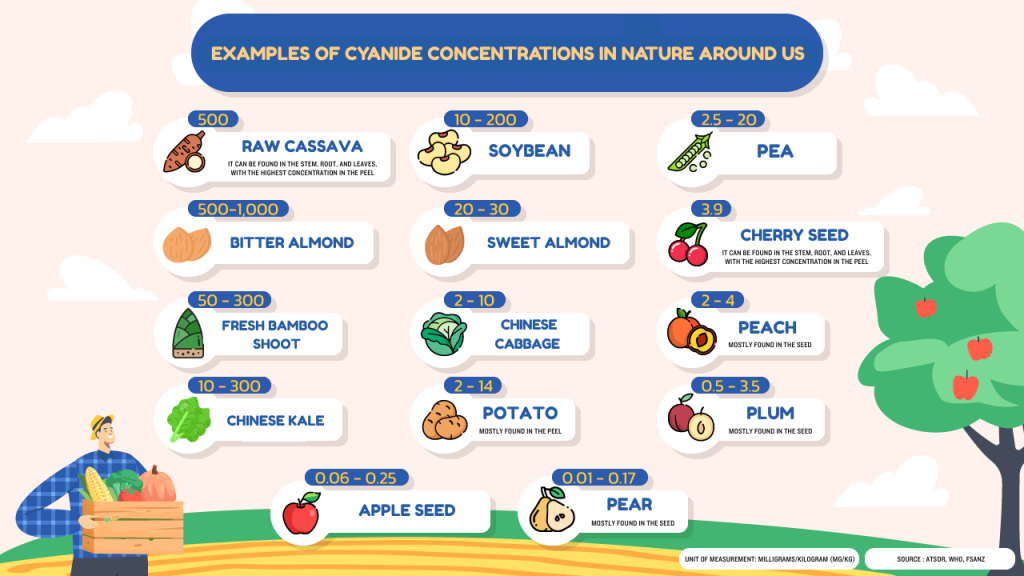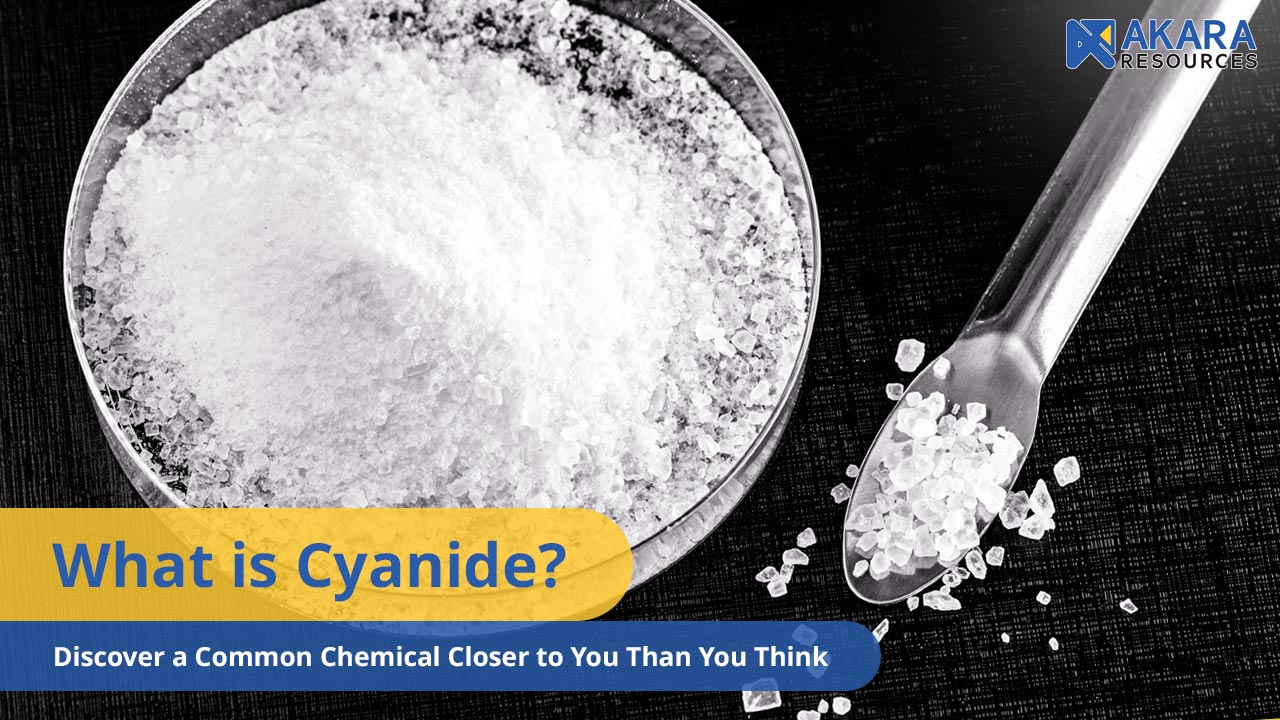Cyanide…Just hearing the name, many people may feel fearful due to news stories, which often lead to significant suspicion. But did you know that cyanide is a chemical substance much closer to us than we think?
In this article, we’ll introduce you to cyanide—what it is, what it looks like, where it can be found, and whether it exists in the natural environment around us. We’ll also explore its potential dangers, its beneficial uses in various industries, and clear up some common misconceptions about cyanide.
Understanding Cyanide: A Chemical Compound Often Considered Dangerous
Cyanide is classified as a Type 3 hazardous substance under the Hazardous Substances Act, B.E. 2535 (1992). Possessing cyanide without permission can result in imprisonment and fines. Chemically, cyanide is a compound consisting of the cyanide ion (CN-) as its main component, made up of carbon (C) and nitrogen (N) atoms. Cyanide exists in several forms, including solid crystalline chunks, white powder, a colorless liquid with no odor, or as a gas that is colorless but may have an almond-like scent.
The surprising truth that many may not know is that cyanide is all around us, subtly blending into our environment in ways we might not even realize.
Cyanide in Nature: A Hidden Presence Closer Than You Think
Cyanide is not only found in laboratories or industrial plants; it also occurs naturally in the environment and is much closer to us than many might realize.

- Vegetables and Fruits: At least 1,000 types of plants and fruits, many of which are familiar to us, can naturally synthesize cyanide. Examples include cotton, hemp, potatoes, yard-long beans, soybeans, turnips, peas, Chinese cabbage, cassava, fresh bamboo shoots, peaches, pears, cherries, plums, corn, apple seeds, and almonds, among others.
- Certain Animals: Some animals also produce cyanide as a defense mechanism. Examples include scorpions, millipedes, ladybugs, common butterflies, and moths.
- Foods and Products: Cyanide can even be found in everyday items, such as coffee, salt, cigarettes, e-cigarettes, and even the jeans we wear.
Cyanide Sounds Dangerous—So Why Aren’t We Affected?
Even though we know cyanide is all around us, have you ever wondered why it doesn’t seem to have any harmful effects on us?
The reason lies in the fact that cyanide exists in various forms. Some types are non-toxic, while others can be highly toxic. On average, the lethal dose of cyanide when ingested orally is about 1-2 milligrams per kilogram of body weight. If the body absorbs a smaller amount of cyanide, it may not be immediately life-threatening, but it can still cause symptoms such as weakness, headaches, dizziness, nausea, vomiting, difficulty breathing, rapid heartbeat, seizures, and potentially even loss of consciousness. The severity of these symptoms depends on the amount, type, and duration of exposure.
Here are some examples of the cyanide levels found in natural sources, such as the fruits and vegetables mentioned earlier:

Note:
- The data in the table represents the average cyanide content in vegetables, which may vary depending on the species, season, and growing conditions.
- Consuming vegetables in normal quantities is not harmful to the body because the cyanide content is very low, and the body can naturally eliminate it.
- It is recommended to wash, peel, or cook vegetables thoroughly with heat before consumption to reduce the cyanide content and other residual toxins found in naturally occurring vegetables and fruits, such as bamboo shoots, Chinese cabbage, cassava, and almonds.
The Use of Cyanide in Various Industries: Benefits and Safety Under Strict Control
In industrial applications, cyanide is considered an important chemical used in manufacturing processes. Cyanide is applied in various industries, including:
- Mining: It is used in extracting gold and other precious metals. Cyanide has been utilized in the gold mining industry since the 19th century due to its effectiveness in dissolving gold in its most stable form.
- Plastic Production: Cyanide is used as a raw material in the production of plastics such as nylon and acrylic.
- Metal Plating: It is used in metal plating processes to enhance the strength, durability, and aesthetics of metals. Examples include gold plating, silver plating, and chrome plating.
- Paper Production: Cyanide, particularly sodium cyanide, is used in the bleaching process of paper pulp to remove lignin, the substance that causes paper to turn yellow. This helps produce white, clean, and high-quality paper.
- Artificial Leather Production: Cyanide is used in the production of synthetic leather to improve surface quality and increase durability.
The use of cyanide in each industry is subject to international standard safety requirements. For example, at our Chatree Gold Mine, we implement innovative controls over cyanide usage, managed by skilled and experienced experts. We use the Sparge system in conjunction with cyanide transport and storage technology (Isotainer) to ensure safe handling, reduce the risk of exposure, and prevent leaks. Additionally, we employ technology to precisely calculate the amount of cyanide needed for each production cycle, ensuring it is used as efficiently as possible.
Our mine’s tailings storage facilities feature a robust five-layer barrier system designed to prevent environmental leakage. Each facility is certified by the Environmental Protection Division of Nevada State, USA, ensuring zero cyanide leakage. The residual cyanide from our gold extraction process naturally degrades through exposure to heat and sunlight, safeguarding the surrounding ecosystem. Additionally, we recycle production water to eliminate any environmental discharge. In emergencies, cyanide antidotes are readily available to treat poisoning.
| Misconceptions About Cyanide, Arsenic, and ManganeseMany people mistakenly believe that cyanide is a heavy metal similar to arsenic and manganese. In reality, cyanide is a chemical compound specifically used in the gold extraction process, not a heavy metal. Conversely, arsenic and manganese are naturally occurring heavy metals found in ore deposits, and they are not utilized in gold mining production. |
Cyanide: A Chemical with Benefits and Risks
Cyanide is a chemical with two significant facets—its benefits in industrial applications and its potential dangers. To ensure the safety of workers, communities, and the environment, cyanide must be used under strict control and management. Although cyanide has been present in our world for centuries, its role in various industries remains crucial despite its toxicity. By understanding its natural toxicity and learning proper handling practices, we can safely harness cyanide’s benefits while protecting both human health and the environment.
References:
Department of Health and Disease Control, Ministry of Public Health
Research on Cyanide Knowledge and International Standards for Cyanide Use by Assoc. Prof. Dr. Phasinu Boonnuan, Assoc. Prof. Dr. Kriangsak Srisuk, and Phoyom Saraphirum
Introduction to Cyanide by Chutarat Asawaranthanavorn, Basic Industrial Department, Department of Basic Industries and Mining
Agency for Toxic Substances and Disease Registry (ATSDR)
World Health Organization (WHO)
Food Standards Australia New Zealand (FSANZ)





